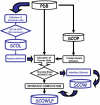SCOWLP: a web-based database for detailed characterization and visualization of protein interfaces
- PMID: 16512892
- PMCID: PMC1459204
- DOI: 10.1186/1471-2105-7-104
SCOWLP: a web-based database for detailed characterization and visualization of protein interfaces
Abstract
Background: Currently there is a strong need for methods that help to obtain an accurate description of protein interfaces in order to be able to understand the principles that govern molecular recognition and protein function. Many of the recent efforts to computationally identify and characterize protein networks extract protein interaction information at atomic resolution from the PDB. However, they pay none or little attention to small protein ligands and solvent. They are key components and mediators of protein interactions and fundamental for a complete description of protein interfaces. Interactome profiling requires the development of computational tools to extract and analyze protein-protein, protein-ligand and detailed solvent interaction information from the PDB in an automatic and comparative fashion. Adding this information to the existing one on protein-protein interactions will allow us to better understand protein interaction networks and protein function.
Description: SCOWLP (Structural Characterization Of Water, Ligands and Proteins) is a user-friendly and publicly accessible web-based relational database for detailed characterization and visualization of the PDB protein interfaces. The SCOWLP database includes proteins, peptidic-ligands and interface water molecules as descriptors of protein interfaces. It contains currently 74,907 protein interfaces and 2,093,976 residue-residue interactions formed by 60,664 structural units (protein domains and peptidic-ligands) and their interacting solvent. The SCOWLP web-server allows detailed structural analysis and comparisons of protein interfaces at atomic level by text query of PDB codes and/or by navigating a SCOP-based tree. It includes a visualization tool to interactively display the interfaces and label interacting residues and interface solvent by atomic physicochemical properties. SCOWLP is automatically updated with every SCOP release.
Conclusion: SCOWLP enriches substantially the description of protein interfaces by adding detailed interface information of peptidic-ligands and solvent to the existing protein-protein interaction databases. SCOWLP may be of interest to many structural bioinformaticians. It provides a platform for automatic global mapping of protein interfaces at atomic level, representing a useful tool for classification of protein interfaces, protein binding comparative studies, reconstruction of protein complexes and understanding protein networks. The web-server with the database and its additional summary tables used for our analysis are available at http://www.scowlp.org.
Figures





Similar articles
-
SCOWLP classification: structural comparison and analysis of protein binding regions.BMC Bioinformatics. 2008 Jan 8;9:9. doi: 10.1186/1471-2105-9-9. BMC Bioinformatics. 2008. PMID: 18182098 Free PMC article.
-
Domain-based small molecule binding site annotation.BMC Bioinformatics. 2006 Mar 17;7:152. doi: 10.1186/1471-2105-7-152. BMC Bioinformatics. 2006. PMID: 16545112 Free PMC article.
-
Characterization of interfacial solvent in protein complexes and contribution of wet spots to the interface description.Proteins. 2007 Jun 1;67(4):1087-95. doi: 10.1002/prot.21394. Proteins. 2007. PMID: 17397062
-
Automatic annotation of protein function.Curr Opin Struct Biol. 2005 Jun;15(3):267-74. doi: 10.1016/j.sbi.2005.05.010. Curr Opin Struct Biol. 2005. PMID: 15922590 Review.
-
Interaction-site prediction for protein complexes: a critical assessment.Bioinformatics. 2007 Sep 1;23(17):2203-9. doi: 10.1093/bioinformatics/btm323. Epub 2007 Jun 22. Bioinformatics. 2007. PMID: 17586545 Review.
Cited by
-
PBSword: a web server for searching similar protein-protein binding sites.Nucleic Acids Res. 2012 Jul;40(Web Server issue):W428-34. doi: 10.1093/nar/gks527. Epub 2012 Jun 11. Nucleic Acids Res. 2012. PMID: 22689645 Free PMC article.
-
Considerations of Protein Subpockets in Fragment-Based Drug Design.Chem Biol Drug Des. 2016 Jan;87(1):5-20. doi: 10.1111/cbdd.12631. Epub 2015 Aug 31. Chem Biol Drug Des. 2016. PMID: 26307335 Free PMC article.
-
Computational study and peptide inhibitors design for the CDK9 - cyclin T1 complex.J Mol Model. 2013 Apr;19(4):1711-25. doi: 10.1007/s00894-012-1735-2. Epub 2013 Jan 8. J Mol Model. 2013. PMID: 23296566
-
Dockground: A comprehensive data resource for modeling of protein complexes.Protein Sci. 2018 Jan;27(1):172-181. doi: 10.1002/pro.3295. Epub 2017 Oct 10. Protein Sci. 2018. PMID: 28891124 Free PMC article.
-
Oligomeric interfaces under the lens: gemini.PLoS One. 2010 Mar 25;5(3):e9897. doi: 10.1371/journal.pone.0009897. PLoS One. 2010. PMID: 20360856 Free PMC article.
References
-
- Argos P. An investigation of protein subunit and domain interfaces. Protein Eng. 1988;2:101–113. - PubMed
Publication types
MeSH terms
Substances
LinkOut - more resources
Full Text Sources

